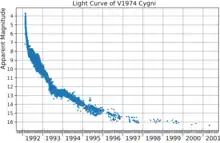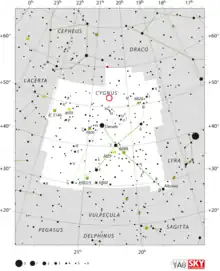| Observation data Epoch J2000.0 Equinox J2000.0 | |
|---|---|
| Constellation | Cygnus |
| Right ascension | 20h 30m 31.61s[2] |
| Declination | +52° 37′ 51.3″[2] |
| Apparent magnitude (V) | 4.3 (max) >21 (min)[3] |
| Astrometry | |
| Distance | 1631+261 −131[3] pc |
| Characteristics | |
| Variable type | neon nova[4] |
| Other designations | |
| Database references | |
| SIMBAD | data |

V1974 Cygni or Nova Cygni 1992 was a nova, visible to the naked eye, in the constellation Cygnus. It was discovered visually with 10×50 binoculars on February 19, 1992, by Peter Collins, an amateur astronomer living in Boulder, Colorado. At that time he first noticed it, it had an apparent magnitude of 7.2. Nine hours later he saw it again, and it had brightened by a full magnitude. For this discovery Collins was awarded the AAVSO Nova Award in 1993.[6][7] The nova reached magnitude 4.4 at 22:00 UT on 22 February 1992. Images from the Palomar Sky Survey taken before the nova event showed identified a possible precursor which had photographic magnitudes of 18 (blue light) and 17 (red light), but the identification of the precursor is not firm.[8][9]
V1974 Cygni declined from peak brightness by three magnitudes in 43 days, making it a "fast" nova.[10] Its light curve is classified as type P (Plateau), and it may be a recurrent nova.[11]
In 1995, V1974 Cygni was observed with the Very Large Array at 1.49, 4.9, 8.4, 14.9 and 22.5 GHz.[12] It was also studied with the Hubble Space Telescope instrument the High Speed Photometer.[13] The instrument recorded a short amount of ultraviolet photometry.[13] The nova was also observed in the far-ultraviolet by Voyager 2.[14] It was observed, but not detected, with the Compton Gamma Ray Observatory.[15] It was the first nova to be observed throughout the electromagnetic spectrum, from radio waves to γ-rays.[16]

All novae are binary stars, with a "donor" star orbiting a white dwarf. The two stars are so close to each other that matter is transferred from the donor to the white dwarf. In the case of V1974 Cygni, the binary's orbital period is 1 hour, 57 minutes. The nova has an oxygen-neon-magnesium white dwarf primary, making it a neon nova.[9] Estimates of the mass of the white dwarf range from 0.98 M☉ to 1.12M☉, and it is estimated to be acquiring 3.2 × 10−10 M☉ yr−1 of material from the donor star.[17]
V1974 Cygni has a nova remnant shell which has been observed several times with the Hubble Space Telescope, as well as with the Infrared Space Observatory. The shell is nearly circular, and its radius as of 10 February 1998 was 0.983 arc seconds. It is expanding at a rate of about 0.26 milli arc seconds per day.[16] The remnant was also imaged in 6 cm radio waves with the MERLIN interferometer.[12]
See also
References
- ↑ "Nova Cygni 1992". esahubble.org. ESA. Retrieved 4 January 2021.
- 1 2 Cutri, Roc M.; Skrutskie, Michael F.; Van Dyk, Schuyler D.; Beichman, Charles A.; Carpenter, John M.; Chester, Thomas; Cambresy, Laurent; Evans, Tracey E.; Fowler, John W.; Gizis, John E.; Howard, Elizabeth V.; Huchra, John P.; Jarrett, Thomas H.; Kopan, Eugene L.; Kirkpatrick, J. Davy; Light, Robert M.; Marsh, Kenneth A.; McCallon, Howard L.; Schneider, Stephen E.; Stiening, Rae; Sykes, Matthew J.; Weinberg, Martin D.; Wheaton, William A.; Wheelock, Sherry L.; Zacarias, N. (2003). "VizieR Online Data Catalog: 2MASS All-Sky Catalog of Point Sources (Cutri+ 2003)". CDS/ADC Collection of Electronic Catalogues. 2246: II/246. Bibcode:2003yCat.2246....0C.
- 1 2 Schaefer, Bradley E. (December 2018). "The distances to Novae as seen by Gaia". Monthly Notices of the Royal Astronomical Society. 481 (3): 3033–3051. arXiv:1809.00180. Bibcode:2018MNRAS.481.3033S. doi:10.1093/mnras/sty2388. S2CID 118925493.
- ↑ Hachisu, Izumi; Kato, Mariko (January 2016). "Light-curve Analysis of Neon Novae". The Astrophysical Journal. 816 (1): 26. arXiv:1511.06819. Bibcode:2016ApJ...816...26H. doi:10.3847/0004-637X/816/1/26. S2CID 118690985.
- ↑ "V1974 Cygni". SIMBAD. Centre de données astronomiques de Strasbourg. Retrieved 2021-01-04.
- ↑ "Peter Collins Discovered V1974 Cygni With Binoculars Feb. 19, 1992". Earth and Space News. 12 February 2020. Retrieved 4 January 2021.
- ↑ "V1974 Cyg (Nova Cygni 1992)". aavso.org. AAVSO. Retrieved 4 January 2021.
- ↑ Hurst, G.M. (June 1992). "Nova Cygni 1992". Journal of the British Astronomical Association. 102: 124. Bibcode:1992JBAA..102..124H.
- 1 2 De Young, James A.; Schmidt, Richard E. (August 1994). "The Photometric Period of V1974 Cygni (Nova Cygni 1992)". Astrophysical Journal Letters. 431: L47. Bibcode:1994ApJ...431L..47D. doi:10.1086/187469.
- ↑ Özdönmez, Aykut; Ege, Ergün; Güver, Tolga; Ak, Tansel (May 2018). "A new catalogue of Galactic novae: investigation of the MMRD relation and spatial distribution". Monthly Notices of the Royal Astronomical Society. 476 (3): 4162–4186. arXiv:1802.05725. Bibcode:2018MNRAS.476.4162O. doi:10.1093/mnras/sty432. S2CID 73722195. Retrieved 4 January 2021.
- ↑ Strope, Richard J.; Schaefer, Bradley E.; Henden, Arne A. (July 2010). "Catalog of 93 Nova Light Curves: Classification and Properties". The Astronomical Journal. 140 (1): 34–62. arXiv:1004.3698. Bibcode:2010AJ....140...34S. doi:10.1088/0004-6256/140/1/34. S2CID 118537823. Retrieved 4 January 2021.
- 1 2 Hjellming, R.M (1995). "Radio Images and Light Curves for Nova V1974 Cygni 1992". Cataclysmic Variables. Astrophysics and Space Science Library. Vol. 205. Dordrecht: Springer. p. 139. Bibcode:1995ASSL..205..139H. doi:10.1007/978-94-011-0335-0_29. ISBN 978-94-010-4148-5. Retrieved 4 January 2021.
- 1 2 Ultraviolet photometry of Nova Cygni 1992 obtained with the high speed photometer
- ↑ Ulivi, Paolo; Harland, David M (2007). Robotic Exploration of the Solar System Part I: The Golden Age 1957-1982. Springer. p. 449. ISBN 9780387493268.
- ↑ Shrader, C.R.; Gehrels, N. (July 1995). "Recent Results from the Compton Gamma Ray Observatory". Publications of the Astronomical Society of the Pacific. 107: 606. Bibcode:1995PASP..107..606S. doi:10.1086/133600. S2CID 123234007.
- 1 2 Krautter, Joachim; Woodward, Charles E.; Schuster, Michael T.; Gehrz, Robert D.; Jones, Terry J.; Belle, Kunegunda; Evans, A.; Leyers, S.P.S.; Starrfield, Sumner; Truran, James; Greenhouse, Matthew A. (November 2002). "Hubble Space Telescope NICMOS Observations of Classical Nova Shells". The Astronomical Journal. 124 (5): 2888–2898. Bibcode:2002AJ....124.2888K. doi:10.1086/343833.
- ↑ Shara, Michael M.; Prialnik, Dina; Hillman, Yael; Kovetz, Attay (June 2018). "The Masses and Accretion Rates of White Dwarfs in Classical and Recurrent Novae". The Astrophysical Journal. 860 (2): 110. arXiv:1804.06880. Bibcode:2018ApJ...860..110S. doi:10.3847/1538-4357/aabfbd. S2CID 55851634.
